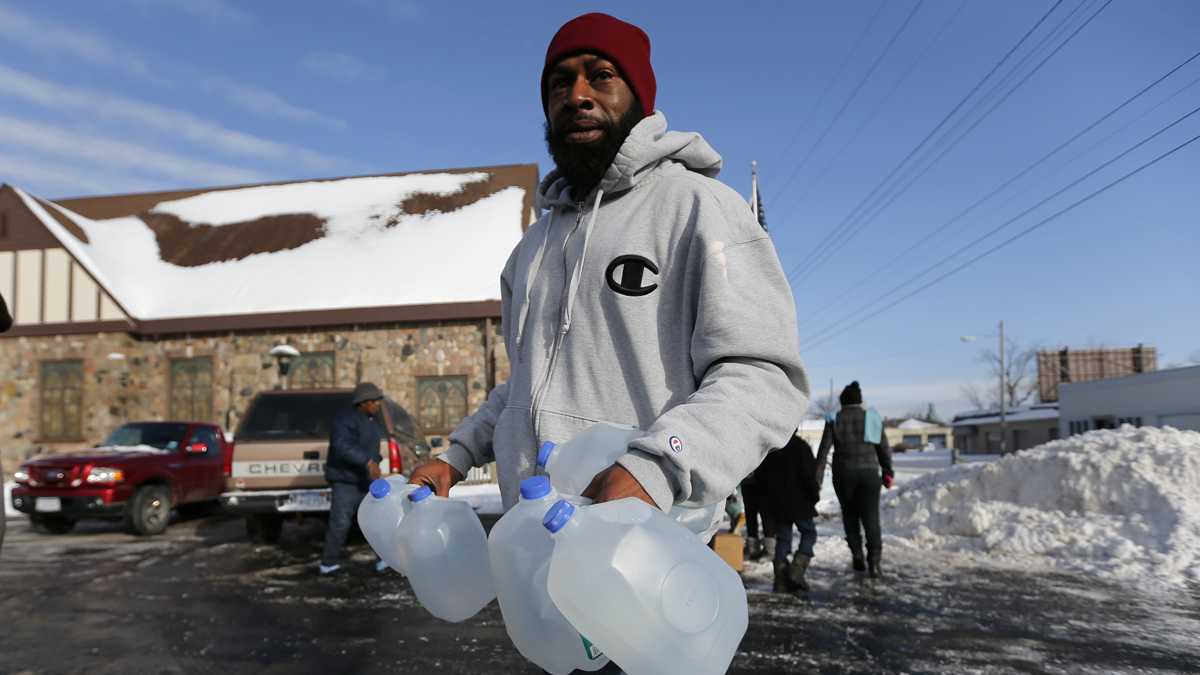Flint is just the latest example of America’s environmental racism

Lemott Thomas carries free water being distributed at the Lincoln Park United Methodist Church in Flint, Michigan. (AP Photo/Paul Sancya)
There is rage surrounding the discovery that the water supply in Flint, a majority black and impoverished city in Michigan, contains unacceptably high levels of lead.
The poisoned water, which is brown, malodorous and bitter, according to residents, is a national scandal that began when the state appointed an emergency manager to oversee the financially beleaguered city, and switched the source of Flint’s water from Lake Huron to the Flint River. The state failed to treat the water correctly, the water corroded the pipes, and for more than a year, the city has been subjected to lead poisoning, which can be fatal, especially for children.
But the Flint situation, as bad as it seems, is not unique. Cities all over the country, primarily in poor and majority black communities, have long been subject to the kinds of environmental hazards that have put people at risk for brain damage, disease, and even death.
Just as in other communities, Flint has found that their poisoned water can be traced directly to the government. Perhaps more importantly, they’ve found that the problem could have been avoided if their elected representatives had simply listened.
“If we hadn’t continued to scream out and shout out that there was problems with the water, we would still have leadership telling people that the water was fine; that there was nothing wrong with it.” Bishop Bernadel Jefferson, a Flint community leader, told me in a radio interview.
“You turn the faucet on to get a glass of water and it comes out brown … Just constantly telling those that are in leadership that there was a problem, and nobody wanted to hear it. But we kept screaming. We even went—you know the governor said he didn’t know–but we were in Lansing in February 2015. We went there to tell him that there was problems with the water.”
Gov. Rick Snyder didn’t listen to the community, Jefferson said. But now that the problem is a national spectacle, Flint has become the latest example of America’s environmental injustice; an injustice that’s often driven by race.
I spoke to Ronald White, who serves as the Director of Regulatory Policy for the Center of Effective Government. He told me in a radio interview that there are more than 12,000 facilities in the United States that store extremely hazardous chemicals. The people most likely to live near those places are impoverished people of color.
In one such community, Richmond, California, a 2012 explosion at a Chevron facility caused a toxic cloud to engulf the neighborhood, causing 15000 people to seek medical treatment for breathing problems, headaches and other problems. A historically black town in Louisiana has had it even worse, said White.
“Mossville, Louisiana is a town established by freed slaves in the late 1700s … And now, Mossville is surrounded by 14 different heavy industry facilities that produce toxic pollution,” White said. “It’s gotten to the point where people in that community are dying from higher rates of cancer, have other kinds of health problems.”
The town is essentially being wiped off the map, White said. And it’s not just happening in the south. It’s happened right here in Pennsylvania.
In 1995, the Environmental Protection Agency Region III, in partnership with the state, completed the Chester Risk Assessment Project, which was part of an initiative to study environmental risks, health, and regulatory issues in Chester.
The EPA noted in a subsequent report that 70 percent of residents in Chester were minorities, and that the community had the highest concentration of industrial facilities in Pennsylvania, including two oil refineries, a large medical waste facility, and other medical waste type facilities. The Delaware County wastewater treatment plant and a large trash to steam facility were also located in Chester.
Chester, at the time, had the highest infant mortality rate coupled with the lowest birth rate in the state. Chester was also the poorest community in Delaware County.
“Blood lead in Chester children is unacceptably high with 60 percent of the children’s blood levels above the Center for Disease Control’s recommended maximum level,” the report said. “Both cancer and non-cancer risks from the pollution sources at locations in Chester exceed what EPA believes are acceptable.”
The report found that air emissions from facilities in and around Chester provide a large component of the cancer and non-cancer risk to the citizens of Chester.
In other words, what’s happening in Flint is not new. It’s been happening for decades, in cities all over this country, and it’s more than just happenstance. Sometimes, according to Ronald White, of the Center of Effective Government, its environmental racism.
If we truly believe that the people of Flint deserve justice, then we must by extension examine what’s happening in communities of color all over America.
If we refuse to act, we are helping to kill off an entire class of people. If we sit still, we are sanctioning racism.
Listen to Solomon Jones weekdays from 7 to 10 am on 900 am WURD
WHYY is your source for fact-based, in-depth journalism and information. As a nonprofit organization, we rely on financial support from readers like you. Please give today.


